Clinical Center News
Pharmaceutical Development Section upgrades to new, tailor-made space
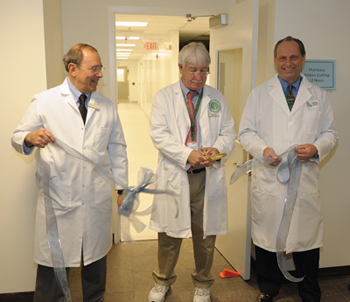 |
Pharmaceutical Development Section Chief George Grimes, Jr., does the honors at a ribbon-cutting on January 8 noting the new space for the section. He gets some support from CC Director Dr. John I. Gallin (left) and Pharmacy Chief Robert DeChristoforo.
|
The unique and groundbreaking work of the Clinical Center calls for clinical trial drugs not always available from a study sponsor; so we make our own.
The CC Pharmacy Department Pharmaceutical Development Section (PDS) was established in 1956 and has operated in several areas over the last half-century. Evolving good manufacturing practices, as mandated by the Food and Drug Administration, presented an opportunity to upgrade the PDS environment and equipment in a new space created especially for the section.
PDS is tasked with formulating and analyzing vaccines and medications not able to be purchased from manufacturers. These products account for one-third of the 1,000 separate drugs (including placebos and varying strengths) that the CC uses in its research protocols, said PDS Chief George Grimes, Jr. An example is a topical, sterile gel of resiniferatoxin, which PDS is developing for research into its utility as a pain treatment in an upcoming National Institute of Dental and Craniofacial Research protocol from Dr. Mike Iadarola, chief of the NIDCR Integrative Neurobiology and Neuronal Gene Expression Unit, and Dr. Andrew Mannes, staff clinician in the CC Department of Anesthesia and Surgical Services.
The section also registers and packages all drugs obtained from an outside pharmaceutical company for use in CC clinical trials. "We handle all investigational drugs," Grimes said. "In the double-blind studies in particular, all the drugs look alike, so we have to be really good about record-keeping and procedures."
Currently in the Magnuson Building near the Blood Bank, the PDS is ready to move into its newly renovated space between the pediatric clinic and phlebotomy in the coming weeks. The new unit adheres to good manufacturing practices and devotes more space (although the overall area is the same size) to drug development and analytical work than the previous location did.
"To the best of our knowledge there is no other hospital pharmacy in the country that has a facility with the capability of PDS," said DeChristoforo.
A tour of the new space revealed a different room for seemingly every step of their process, allowing for better air and overall quality control, Grimes said. Where staffers work with HIV-infected blood in the Clinical Pharmacokinetic Research Laboratory, for example, negative air flow (pulling more air in than is pumped out) and the use of a biological safety cabinet decreases the risk of contamination outside the confines of the laboratory. Clinical Pharmacokinetic Research Laboratory staff characterize how drugs are excreted and metabolized, another function of the PDS.
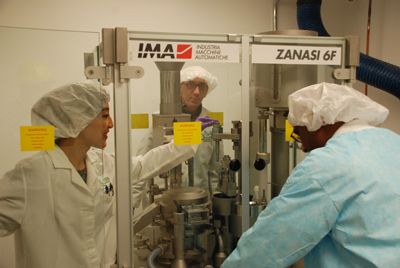 |
PDS staff (from left) Kumi Ishida, Scott Hotaling, and Ram Agarwal adjust the new automatic capsule machine in their section's updated area to prepare for a production run.
|
The section produces three to four sterile product batches and the same amount of tablets and capsule batches a week, Grimes said, though the batch sizes vary. A vaccine will likely be made 1,000 vials at a time, while the number of capsules produced can run from 50 to 100,000. New equipment in the PDS is making that process run smoother—a new tablet-making machine has more safety measures than the old one from the 1950s, and the new equipment to make capsules runs at a much faster pace, Grimes said.
Before and after production, the pharmaceuticals and their components go to the PDS Analytical and Quality Control Unit, under lab chief Gopal Potti, to make sure they are as they should be—right product, pure grade. Even after the drug has been dispensed to patients, monitoring continues on quarantined samples to assure stability over time, Grimes said.
Grimes did the honors at a ribbon-cutting on January 8, unveiling the improvements that will allow the PDS to possibly expand its output to serve off-site researchers. "My hope is this facility will have the capacity not only to meet the needs of all of our intramural investigators," NIH Clinical Center Director Dr. John I. Gallin said, "but also help some of our extramural colleagues."
Back to Top
NIH partners with DC to advance research and fight HIV/AIDS
In an effort to combat the HIV/AIDS prevalence in Washington, DC—the highest in the country—NIH and the DC Department of Health have teamed up for the DC Partnership for HIV/AIDS Progress. The program was initiated on World AIDS Day 2007 by Dr. Anthony Fauci, director of the National Institute of Allergy and Infectious Diseases, and Dr. Henry Masur, chief of the Clinical Center Critical Care Medicine Department.
"Our nation's capital has one of the highest rates of HIV/AIDS, where about 3 percent of adults and adolescents are infected with the virus," said Fauci, a long-time District resident, at a press conference with DC Mayor Adrian Fenty at the Family and Medical Clinic in Southeast Washington on January 12. The NIH Office of AIDS Research is sponsoring the project with the CC and NIAID co-leading the partnership. "Not only are we going to, as a team, turn things around in the District. We're going to make DC a model for the rest of the country and the world on how to do it right," Fauci said.
The partnership centers on four research efforts that include creating a city-wide patient data base, establishing a prevention research program, studying methods to improve linkage to care, and improving HIV subspecialty care for underinsured patients.
Masur is leading the effort that will embed NIH specialists in community clinics to focus on improving care and enhancing intramural research. The initial focus of these clinics will be hepatitis C, since a needs survey of DC providers identified this area as a top priority. Diabetes, cardiovascular disease, mental health, and AIDS-related malignancies are other areas that this program will likely target.
Three clinics established so far are collaborations with Family & Medical Counseling Service, Inc. in Southeast; Walker Jones Health Center of Unity Health Services in Northeast; and Whitman-Walker Clinic in Northwest, with hopes to expand in the future. Dr. Dawn Fishbein was recruited from New York City's Mount Sinai Medical Center to lead the clinic efforts, and to date more than 100 new patients have been seen at the three sites by NIH staff in collaboration with their clinic partners.
"The goals of the clinics are to enhance subspecialty medical care, to improve access to cutting-edge research, and to accelerate the completion of intramural studies that will inform medical practice and public policy on issues of highest relevance to DC residents," Masur said.
Whitman-Walker Clinic chief medical officer Dr. Raymond Martins is optimistic about the DC Partnership. "The problem is bigger than one group can handle," Martins said. "It needs this cohort. Whitman-Walker Clinic is proud to be a part of this new initiative."
Through NIH Office of AIDS Research leadership, other institutes are being encouraged to participate in this effort to foster more intramural research into the full scope of HIV/AIDS.
"Success will be measured by the subspecialty clinical care in the District that is enhanced, by the intramural research that is facilitated and stimulated, and by the number of specialists and investigators who are attracted to the District to make DC a leader in dealing effectively with urban HIV/AIDS," said Masur.
Back to Top
CC Veterinary Care Program protects partners in research
By: Nicole Martino
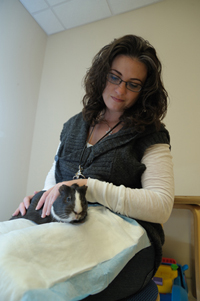 |
Monica Bur, Veterinary Care Program coordinator, checks in with Harmony, the CC's resident guinea pig who visits with patients and their family members.
|
Every day Clinical Center investigators work toward medical advances that will lead to safe and effective drugs, therapies, and cures, yet many of the diseases and disorders studied at the CC are not conquered by people alone. What researchers learn through studies involving animals contributes to human health, and as the value of laboratory animals cannot be understated, it is equally important to ensure their humane treatment.
The CC Veterinary Care Program's responsibility is to maintain the balance between promoting human health and protecting animal welfare. Dr. Lisa Portnoy is a laboratory animal veterinarian and the CC Veterinary Care Program director. She keeps an eye out for all of the animals in the CC, great and small—from the mice and rats imperative to investigators' protocols to the animal-assisted therapy (AAT) dogs on their weekly visits to patient-care units.
"The best part is when research performed on animals leads to treatments that actually get used on patients. It is the most rewarding when you know that the animals'purpose was realized," said Portnoy, who along with Monica Bur, Veterinary Care Program coordinator, reviews animal care and use protocols submitted for proposed research using animals. They also are members of a committee, somewhat like an institutional review board, known as the CC Animal Care and Use Committee that is tasked with maintaining responsible conditions for laboratory animal subject research.
"The most important part of this program is to make sure that the animals are treated humanely and properly, above all that is our purpose here. So we make sure from the animal care staff to the investigators that everyone is properly trained, knows how to handle the animals, knows what has been approved on the protocols—what they are allowed and what they aren't allowed to do," said Portnoy.
In addition to maintaining the care and use of research animals, the Veterinary Care Program is responsible for ensuring that all AAT and service dogs that visit patient-care areas of the CC meet appropriate NIH guidelines.
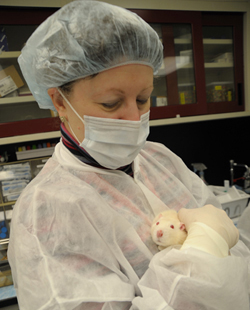 |
The most common laboratory research animals that the Veterinary Care Program works with are mice and rats like the one held by Dr. Lisa Portnoy, CC Veterinary Care Program director.
|
The AAT Program, run in conjunction with the CC Rehabilitation Medicine Department Recreation Therapy Section, lets patients experience the companionship and the unconditional love dogs bring some people. The therapy dogs and their owners are volunteers from National Capital Therapy Dogs, Inc., and visit the CC patient-care units and recreation therapy areas two Monday evenings and two Tuesday mornings a month. Before they have any contact with patients, Portnoy gives each dog a full exam—nose-to-tail—to make sure that each meet health and behavior requirements.
"I really enjoy having the volunteers come in and seeing the patients getting benefit from the AAT Program," said Portnoy who recently got her own dog, a former research beagle, certified as a therapy dog.
Portnoy also examines patients' service animals that are going to be in patient-care areas. Just like patients who have appointments with CC doctors and investigators, all visiting service dogs have an appointment with Portnoy. She obtains the animals' health records to assure they are up-to-date on required vaccinations and examines them upon arrival for temperament.
One of Portnoy's other responsibilities is to keep an eye on the residential guinea pig that lives in the CC main playroom. The guinea pig, named Harmony, receives daily visits by a member of the CC vetrinary care staff to ensure her health and the health of the patients seeking her company. "Guinea pigs are great for the kids," said Bur, "They are docile, friendly, and cooperate with kids really well.
Back to Top
Surgery spaces renovated to improve process for patients and visitors
Surgery is a multi-step process, not only for patients, but for their loved ones, too. Recognition of the stakeholders and the several stages involved in preparing for an invasive procedure led to a recently completed renovation of some areas of the Clinical Center Department of Anesthesia and Surgical Services.
"We generated a physical plan that took into account each step of the peri-surgical process," said DASS Chief Dr. Zena Quezado. Plans for the update began more than five years ago, with construction started in 2006. The area opened for business on December 14.
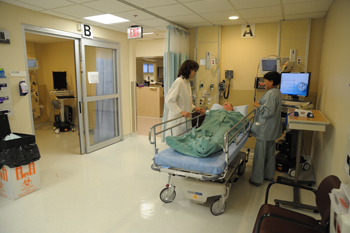 |
DASS chief Dr. Zena Quezado (right) and PACU nurse Josephine Nierva demonstrate patient care in the new DASS pre-procedure holding area. The new suite features enclosed rooms for isolation patients.
|
The pre-anesthesia clinic now boasts three interview and exam areas (compared to its previous one) and a separate waiting area, which allows for more privacy and a more relaxed setting, said nurse Peggy Fessler. At the clinic, patients scheduled for surgery review the planned procedure and the risks of anesthesia with staff and have the opportunity to bring up any questions or discuss concerns.
On the day of their surgery, outpatients report to the new waiting area, where loved ones of all surgical patients can wait to hear from the medical team. Closer to the procedure areas and recovery room than its predecessor, the new waiting area features isolated areas where family members and friends can gather separate from other patients' visitors.
Dr. Pamela Stratton, chief of the CC Surgical Administration Committee and chief of the Gynecology Consult Service, Program in Reproductive and Adult Endocrinology, National Institute of Child Health and Human Development, was instrumental in the planning of the new space. "We improved the flow," she said. "This is a unique place with complicated people, and we wanted to manage the outpatient surgeries better. It was bottle-necked before. By acknowledging what was needed for outpatient surgeries, we adapted the space and improved it for all types of surgery."
An appreciated addition to the new space is a private room for sensitive conversations, Quezado said. Another attribute is a volunteer services representative present to answer questions and assist the arriving outpatients and the waiting family and friends.
A bright, new holding area lets the surgical team take proper preparation steps—such as documentation and site marking—efficiently and privately, said nurse manager Susan Rynders. The space has been retrofitted to do some small procedures, such as arterial line placement and lumbar puncture, and includes isolation areas for patients with contagious infections.
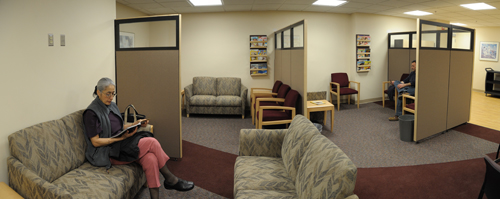 |
A new space for the Department of Anesthesia and Surgical Services family waiting and outpatient arrival area offers separate enclaves for privacy and comfort.
|
Back to Top
Microbiology Society honors two NIH researchers
Two NIH researchers were among those named as 2010 award recipients by the American Society of Microbiology (ASM), honoring their commitment to the organization and to the field.
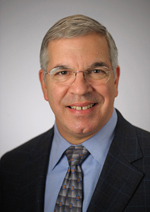 |
Dr. Patrick Murray is chief of the CC DTM Clinical Microbiology Service.
|
Dr. Patrick R. Murray, chief of the Clinical Microbiology Service in the Clinical Center Department of Laboratory Medicine, and an ASM member since 1974, was chosen to receive the ASM Founders Distinguished Service Award. The 2010 laureate of the Abbott Laboratories Award in Clinical and Diagnostic Immunology is Dr. Gene M. Shearer, of the National Cancer Institute Experimental Immunology Branch.
"I was very surprised and pleased when ASM notified me that I was the 2010 recipient of this award. My activities in the society are a source of great personal and professional satisfaction," said Murray, who has been an active ASM volunteer since 1981 and is honored for his years of service to multiple ASM programs. His most visible leadership role has been as the editor-in-chief of four consecutive editions of the Manual of Clinical Microbiology, and he also served for 15 years on the editorial board and as an editor of the Journal of Clinical Microbiology.
Murray began volunteering to the American Board of Medical Microbiology in 1981, and over 13 years served in virtually every leadership position, ultimately being elected board chair in 1991.
"There is no questioning the breadth and depth of service that Murray has given to the ASM, but one must also recognize the outstanding quality of that service," remarked Dr. Michael Pfaller, of the Department of Pathology at the University of Iowa College of Medicine.
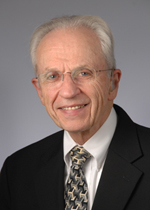 |
Dr. Gene M. Shearer of NCI is honored for his work with HIV.
|
Shearer has been selected for his research on HIV pathogenesis. He began his career at the NIH in 1972, and during the AIDS epidemic, Shearer's research showed that the HIV infection leads to CD4+ T cell dysfunction prior to the loss of such cells and the onset of the clinical disease. His work showed the important role for immune dysregulation in HIV pathogenesis. Shearer defined the molecular mechanisms underlying such dysfunction and made the novel observations that noninfectious HIV particles can be immunopathogenic; and interferon-alpha, which has anti-HIV activity, is important for inducing HIV-mediated immune dysfunction.
"He has repeatedly made insightful scientific observations that have shaped our understanding of the immune response to HIV and has provided a focus for development of immune-based therapy and vaccines," remarked Shearer's nominator, Dr. Alan Landay, chair of the Immunology & Microbiology Department at Rush University Medical Center, Chicago. Shearer said that he was totally shocked upon receiving this honor.
NIH scientists previously recognized by ASM include Dr. Steve Holland, chief of the National Institute of Allergy and Infectious Diseases Laboratory of Clinical Infectious Diseases and 2009 recipient of the Abbott Laboratories Award, and Dr. Susan Gottesman, head of the Biochemical Genetics Section in the National Cancer Institute Laboratory of Molecular Biology and the 2007 recipient of the Founders Distinguished Service Award. Murray and Shearer will be presented their awards at the annual ASM meeting in San Diego in May.
Back to Top
Nursing responds to needs of oncology program
By: NPCS Chief Dr. Clare Hastings
In 2009 the Clinical Center saw a significant increase in admittance of oncology research participants, due to the increased research activity of the National Cancer Institute. In response, CC Nursing and Patient Care Services (NPCS) strategized with NCI nursing colleagues on the best way to support this increased census. Joint planning meetings were convened to review patient flow and clarify services in each patient-care area to best meet research participant and investigator needs. The outcomes of this collaboration were the following:
• By converting day hospital stations to inpatient beds and increasing staffing, the CC opened a 12-bed oncology patient-care unit on 3SE-N.
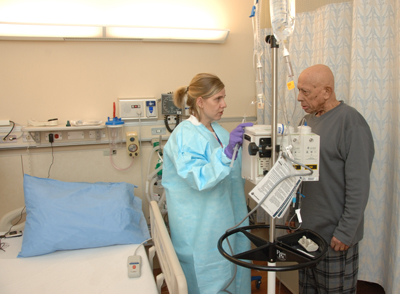 |
Seen with patient Richard Martin, nurse Heather Holdread recently joined the 3SE-N patient-care unit. 3SE-N was converted to an inpatient area from a day hospital to address an increase in oncology research participants.
|
• NPCS and NCI revised the model of care in the outpatient clinics to better support a more acutely ill patient population requiring urgent care assessment, preadmission stabilization, and support during protocol assessments and follow-up visits.
• The CC expanded services in Ambulatory Care to include increased hours in the clinics and the addition of outpatient procedures formerly requiring day hospital visits.
• The increased need for nursing staff was met by a group of oncology-experienced contractors and per diem staff while NPCS conducted a focused recruitment of 71 experienced oncology nurses, eight patient-care technicians (whose skills were expanded to support the oncology services), and a clinical nurse specialist for Surgical Oncology/Immunotherapy.
• Patient flow in the outpatient clinics was improved with the realignment of OP12 and OP13. The space was reconfigured to preserve patient privacy and confidentiality and to better support a chronically and often severely ill patient population, as well as to meet the extensive teaching and counseling needs and the need for discussion, consultation, and image review space for the research team.
• Because oncology as a specialty represents the NPCS largest practice area, the department also enhanced nursing education programs to include the Oncology Education Series, the Association of Pediatric Hematology/Oncology Nurses Chemo-Biotherapy Course, the Oncology Nursing Society Chemo-biotherapy Course, the End-of-Life Nursing Education Consortium Course, the Advanced Oncology Education Series, and the Peripheral Blood Stem Cell Transplant Course. All are presented multiple times throughout the year. In collaboration with NCI, the CC's longstanding Cancer Nursing Fellowship Program has been extended to two years with the goal that graduating fellows with be able to sit for the Oncology Nursing Society certification exam. So far the program boasts 100 percent success of graduates achieving this certification.
• NCI nursing leadership collaborated with NPCS in developing competencies for the clinical research nurse that will have application nationally, both within the specialty and across all research settings.
Back to Top
Art donation asks viewers to 'apprehend these miracles'
Premier local artist Jean Meisel made a generous donation to the Clinical Center this winter of 13 large works, half of which hang in the Magnuson's Building new main corridor.
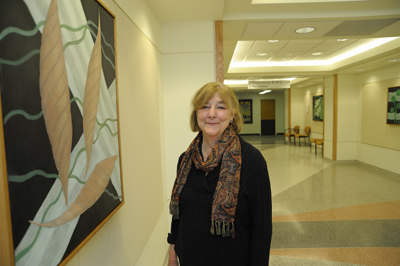 |
Chevy Chase artist Jean Meisel donated 13 works to the CC permanent art collection. Seven pieces that combine natural shapes with geometric abstracts hang in the Magnuson Building's new main corridor.
|
Early last year Meisel mentioned to a contact at a Washington, DC, gallery that she had a wealth of paintings she'd like to share with those who couldn't get out to see them and was told of the CC collection. Curator Lillian Fitzgerald visited Meisel's Chevy Chase farmhouse and chose works she felt would fit the aesthetic of the hospital and create a cohesive showing. The oil paintings join the CC permanent collection, with seven works in the main corridor and six in the Hatfield Building's fifth floor south wing.
The two groupings of Meisel's work show a progression in her creative process. The artist studied English at the University of Michigan and did not start painting professionally until she moved to Georgetown with her young family in 1958. With three children, Meisel balanced motherhood with her work as a painter and a photographer, housing her dark room in the family's downstairs bathroom. She grew quite successful, selling a number of her creations to corporate buyers and showing with The Washington Arts Museum, a non-profit to support local artists, and at the National Museum of Women in the Arts.
 |
The above is one in a series that Meisel said were influenced by her study of Italian painters, among them Giotto and Fra Angelico. These pieces are named after Italian cities and hang on the Hatfield Building's fifth floor.
|
A great source of inspiration for Meisel as her career progressed was the Phillips Collection in DC and particularly the works of abstract artists Milton Avery and Nicolas de Staël. "The complicated and interesting colors, simple shapes …" Meisel said. "It was just gorgeous. I thought, ‘I want to do that.'" Her work went from land and seascapes to color-blocks.
After studying three early Italian painters—Giotto, Fra Angelico, and Piero della Francesca—Meisel's work echoed the dark colors and architectural elements (abstract posts, checkerboards) of those premier artists. "I tried to convey that same sense of reverence and worth," she said.
The pieces from this era of Meisel's career—done in the 1970s—stand four-to-six feet high and just as wide. "If you had something to say, you were going to go big," the artist said.
Her newer works play with black, a color Meisel sees not as depressing, but rather rich and distinguished. She has united her previous subjects, taking natural shapes from her landscape and seascape days and pairing them with the geometric forms.
Her artist's statement explains: "Every day of our lives we are astounded by the glorious and mysterious objects and events in the natural world. In my paintings I isolate shapes and colors and simplify what I see—rocks, leaves, skies, shells—in the hope that the viewer, like the painter, can apprehend these miracles with new eyes."
Back to Top
Raising the bar in patient safety
The Clinical Center always strives to bring our patients the highest quality and safest care possible. In 2009, the CC enhanced its patient safety program by introducing barcode technology, allowing a care team to link patients to their medical orders to assure that critical patient-care activities such as specimen collection, blood transfusion, and medication administration are performed safely and accurately.
In September, barcode technology was implemented in outpatient phlebotomy, and this month, the CC will begin phasing barcode technology into inpatient and outpatient areas, day hospitals, and other CC departments. Critical to the success of this technology is ensuring that all CC patients have a unique barcode.
Currently, wristbands worn by CC inpatients have printed barcodes. Patients are instructed to keep their wristbands on at all times. In February, the CC will begin issuing barcode cards to all outpatients that include the patient's name, photograph, and unique barcode; patients will be instructed to bring it with them on each CC visit.
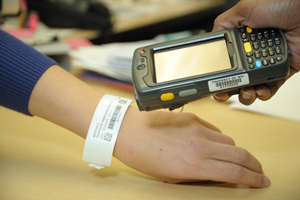 |
Inpatients will have the new barcode printed on their wristbands. Outpatients should visit the P1 barcode station to get a barcode for their extended visitor badge or a barcode card.
|
When a new patient or a current patient registers in Admissions, a barcode card will be issued by Admissions staff. When currently registered patients visit the CC, they will be asked to stop at a barcode station at the P1 Hospitality Services desk adjacent to the South Elevators. Hospitality Services will issue these patients a barcode card or a barcode label to place on their extended visitor badge. Any patient who does not have an extended visitor badge will be provided information and an application form, and if/when a badge is issued, it will include the patient's barcode.
The P1 barcode station will be open Monday through Thursday (9 am to 2 pm) and Friday (9 am to noon). Outpatients are encouraged to visit a Hospitality Services desk for more information, including directions to the barcode station. Care providers who encounter patients without a barcode should not delay care. Instead, patients should be provided with the instructional booklet (Raising the Bar) and directed to visit the barcode station after their appointment.
Back to Top
Ognibene receives Distinguished Service Award
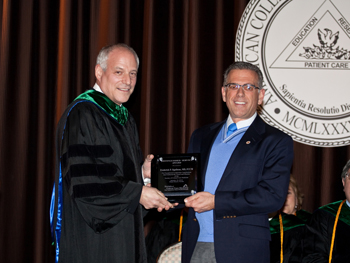 |
The CC's Dr. Frederick P. Ognibene, right, was recently presented the 2009 Distinguished Service Award from the Society of Critical Care Medicine's 2009 president, Dr. Mitchell Levy. Photo credit: Julian Corlaci, SCCM
|
Deputy Director of Educational Affairs and Strategic Partnerships at the Clinical Center, Dr. Frederick P. Ognibene, was awarded the Society of Critical Care Medicine (SCCM)'s 2009 Distinguished Service Award for his exceptional leadership contributions to the society, which have furthered the vision and mission of the SCCM.
Dr. Mitchell Levy, 2009 SCCM president, presented the award at the SCCM annual congress January 10 in Miami. Ognibene was president of the SCCM in 2007 and served nine years on its governing council and executive committee.
The SCCM has 14,000 members and is a multi-professional society comprised of all members of the intensive-care-unit health-care team.
Ognibene was previously a senior investigator in the CC's Critical Care Medicine Department and served as director of the Critical Care Medicine Fellowship Training Program.
Back to Top
Former NIH employee hits 200 blood donations
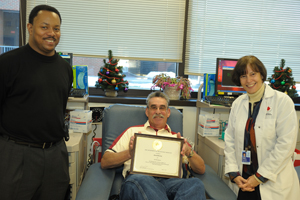 |
Hal Wilkins and Dr. Susan Leitman of the CC Department of Transfusion Medicine present David Blessley with a plaque on January 7 noting his 200th blood donation.
|
With 200 blood donations under his belt, David Blessley is "twice as special" said Dr. Susan Leitman, chief of the Clinical Center's Department of Transfusion Medicine Blood Services Section. At a presentation on January 7 of a plaque noting his commitment, Blessley said of his 40 years of donation, "It's to help somebody else. If I was to need a pint of blood, I'd hope someone else would donate."
Blessley, 65, worked for NIH in Building 12 until his retirement in 2000, but returns to campus every eight weeks or so to give blood and visit with the staff he calls "talented and knowledgeable."
Blood donated to the NIH Blood Bank is used every day of the year to treat CC patients who are participating in the medical treatment and research programs of the NIH. If blood is not required for immediate use, it may be frozen and stored. Fractions of blood unsuitable for transfusion are used for research. Occasionally, blood may be sent elsewhere in the community or the nation where it can be used to help save a life. The NIH Blood Bank is located in the CC, with nearby parking available for donors in MLP-9. Visit http://www.cc.nih.gov/blooddonor/ for more information.
Back to Top
News Briefs
NIH-Duke Training Program in Clinical Research
Applications are being accepted for the 2010-2011 NIH-Duke Training Program in Clinical Research. Established in 1998, the program is designed primarily for physicians and dentists who want formal training in the principles of clinical research. Courses are offered at the Clinical Center via videoconference technology, and academic credit earned may be applied toward a Master of Health Sciences in Clinical Research degree from Duke University School of Medicine. The degree requires 24 credits of graded course work, plus a research project for 12 credits. The program is designed for part-time study, allowing students to integrate academic training with their clinical training.
Applications are available from the CC Office of Clinical Research Training and Medical Education in Building 10, Room B1L403 or via e-mail from Benita Bazemore at bbazemore@cc.nih.gov. Additional information regarding coursework and tuition costs is available on the program Web site at http://tpcr.mc.duke.edu.
Enrollment in this program is limited. The deadline for applying is March 15. Successful applicants will be notified by July 1.
Valuable resource helps NIH community care for dependents
The Dependent Care Resource and Referral Service (DCRRS) sponsored by the NIH Office of Research Services, Division of Amenities and Transportation Services provides information on available resources for those planning or managing care for a parent, sibling, or dependent adult.
Details on adult day care, senior housing options, transportation services, meal services, home health aides, long-distance care giving, and communicating with an adult or elderly relative are offered by the DCRRS. Those interested in information on child care needs, adoption, college planning and special needs resources may find the DCRRS helpful.
NIH employees, trainees, and contractors have access to a resource specialist who can help assess specific needs and offer support through the many demands of work and family. Call 1-800-777-1720 Monday through Friday between 9am and 5pm or visit http://does.ors.od.nih.gov/childcare/ for more information.
Back to Top
Upcoming Events
February 3, 2010
CC Grand Rounds
Lipsett Amphitheater, 12 noon
Ethics Rounds
Navigating Mismatches in Patient Preference and Staff Expertise
John Lantos, MD
Director, Children's Mercy Bioethics Center, Children's Mercy Hospital, Kansas City
Wednesday Afternoon Lecture Series
Masur Auditorium, 3 pm
Stem Cell to T Cell: Molecular Anatomy of Commitment
Ellen Rothenberg, PhD
Albert Billings Ruddock Professor of Biology, California Institute of Technology
February 10, 2010
CC Grand Rounds
Lipsett Amphitheater, 12 noon
Contemporary Clinical Medicine: Great Teachers
Prevention of Cardiovascular Disease
Philip Greenland, MD
Harry W. Dingman Professor, Senior Associate Dean for Clinical and Translational Research, Feinberg School of Medicine
Director, Northwestern University Clinical and Translational Sciences Institute, Northwestern University
Wednesday Afternoon Lecture Series
Masur Auditorium, 3 pm
Neural Plasticity and Diversity in the Adult Mammalian Brain
Fred Gage, PhD
Adler Professor, Laboratory of Genetics, The Salk Institute for Biological Studies
February 17, 2010
CC Grand Rounds
Lipsett Amphitheater, 12 noon
A Clinical Update on Autism and the Autism Spectrum Disorders
Susan E. Swedo, MD
Chief, Pediatrics and Developmental Neuroscience Branch, NIMH
Cognition and Brain Functional Connectivity in Autism
Alex Martin
PhD, Chief, Section on Cognitive Neuropsychology, Laboratory of Brain and Cognition, NIMH
Wednesday Afternoon Lecture Series
Masur Auditorium, 3 pm
Margaret Pittman Lecture
Tuning Depression Circuits Using Deep Brain Stimulation
Helen Mayberg, MD
Professor of Psychiatry and Neurology, and Dorothy Fuqua Chair of Psychiatric Imaging and Therapeutics, Emory University School of Medicine
February 24, 2010
CC Grand Rounds
Lipsett Amphitheater, 12 noon
Deconstructing and Reconstructing Myositis: The Importance of Phenotypes
Lisa G. Rider, MD
Deputy Chief, Environmental Autoimmunity Group, Office of Clinical Research, NIEHS
Frederick W. Miller, MD, PhD
Chief, Environmental Autoimmunity Group, Office of Clinical Research, NIEHS
Wednesday Afternoon Lecture Series
Masur Auditorium, 3 pm
Creating Super-regulatory T Lymphocytes
Michael Dustin, PhD
Irene Diamond Professor of Immunology and Professor of Pathology, New York University Langone Medical Center
Back to Top
This page last updated on 12/14/2017


 The information on this page is archived and provided for reference purposes only.
The information on this page is archived and provided for reference purposes only.